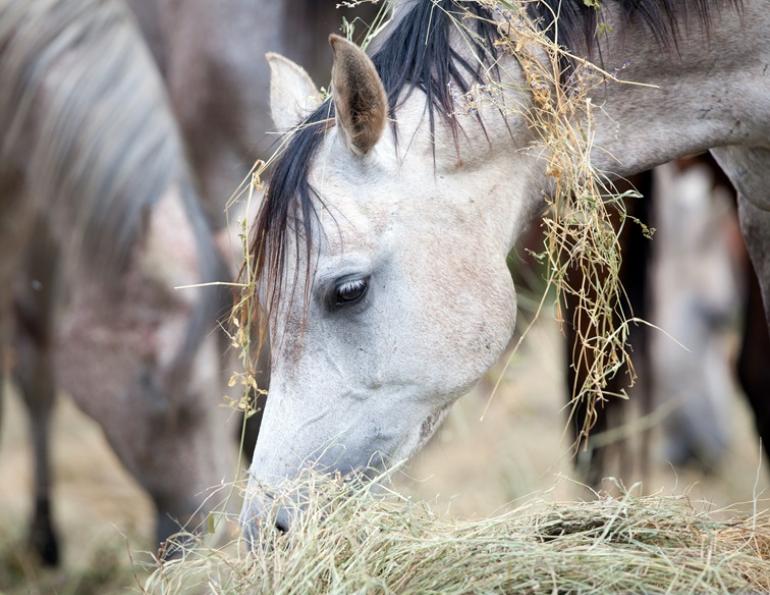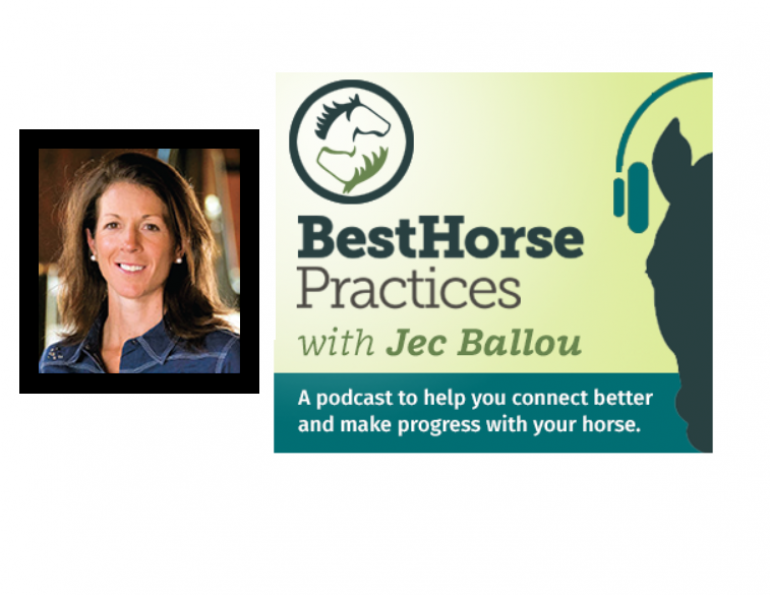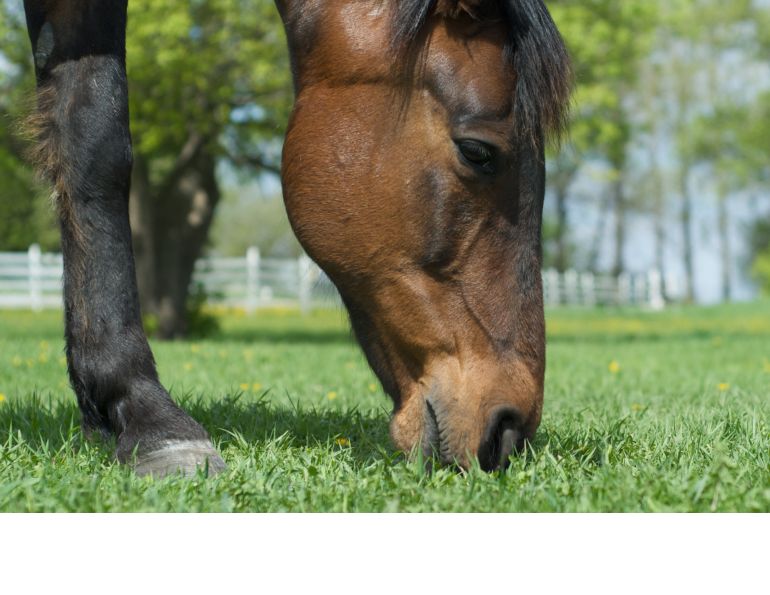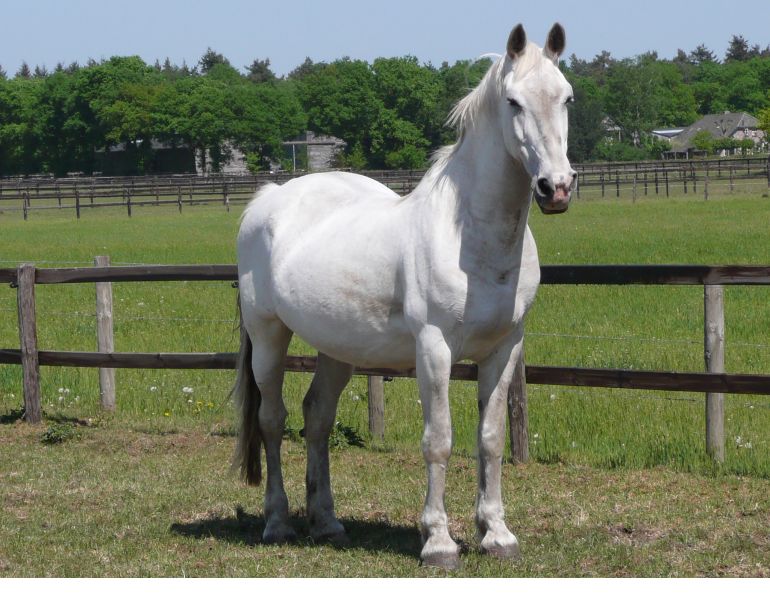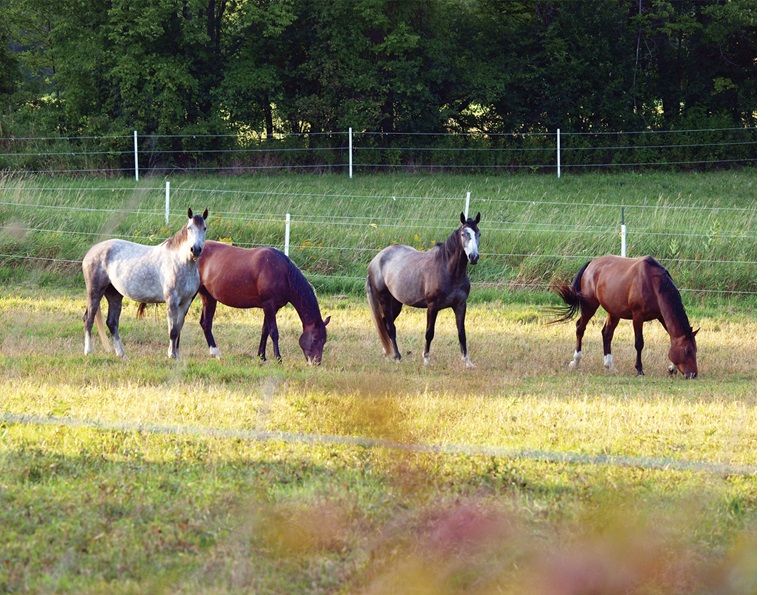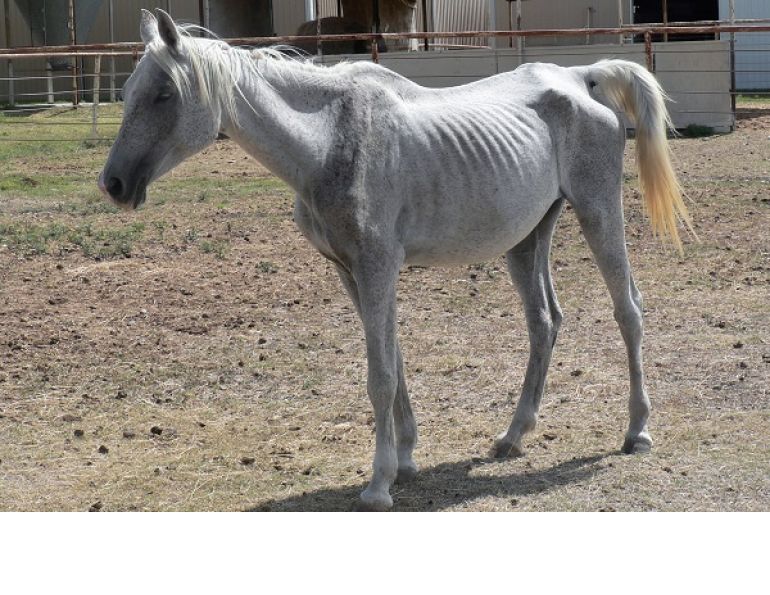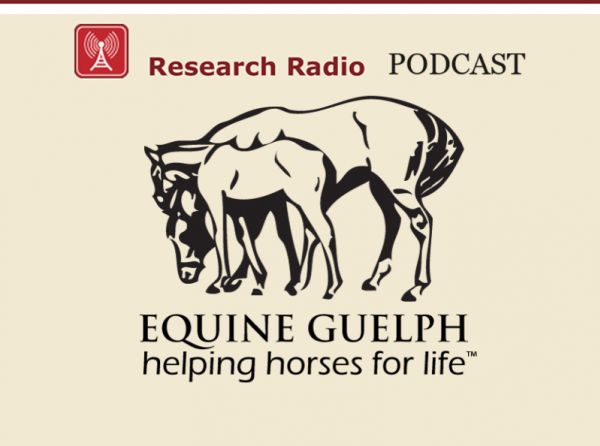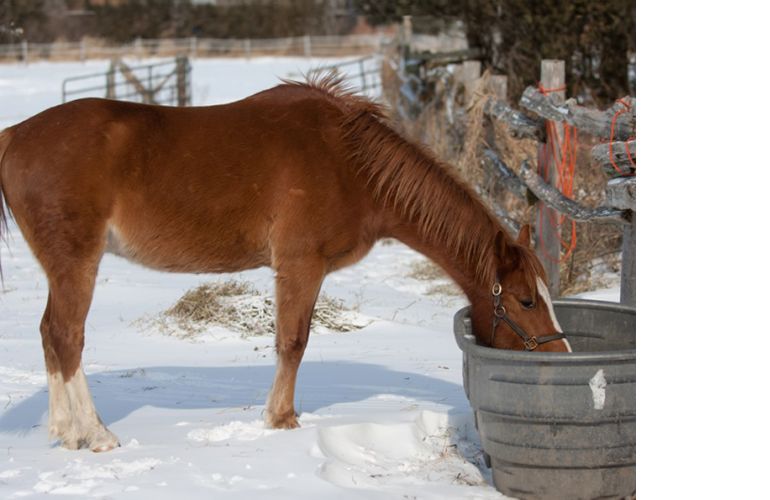By Madeline Boast, MSc. Equine Nutrition
Most horses are maintained on a forage-based diet, meaning that the primary component of their daily ration is hay or pasture. In the equine nutrition world, the term “forage-first” has gained popularity. This feeding practice provides a multitude of clearly-reported health benefits, such as reduced risk of gastric ulceration and stereotypical behaviours. However, simply allowing your horse to have free choice access to hay or pasture is not enough to ensure optimal nutrition.
Additional nutrients are required, and there are some key considerations that go into accurately feeding a forage-based diet to optimize the horse’s nutritional well-being.
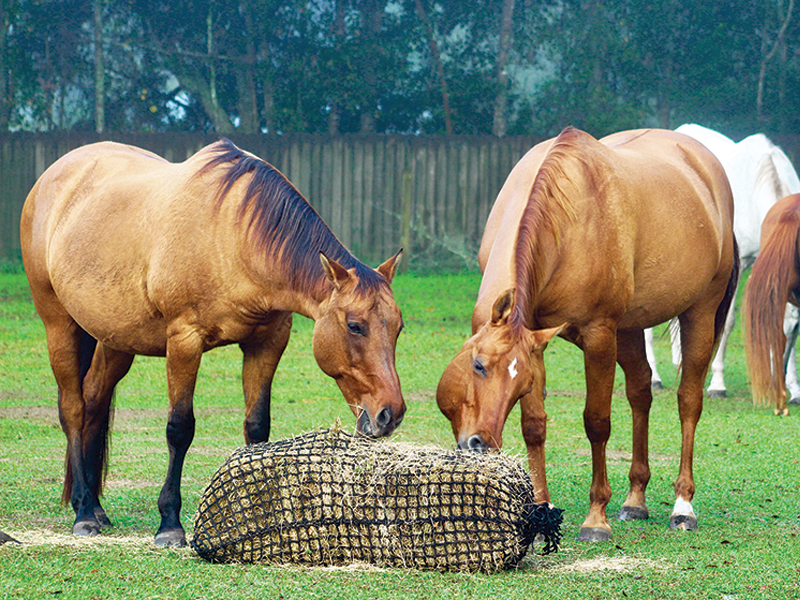
Horses evolved as trickle feeders and are meant to consume small meals frequently. Photo: AdobeStock/Kimberley
When considering a forage-based diet for your horse, or if your horse is already consuming one, understanding the why is important. Horses are herbivores that have evolved as trickle feeders, meaning their digestive tract is most effective when consuming small amounts of feed frequently. In the wild, horses are free-range on grasslands. This has resulted in horses being adapted to consuming large amounts of high-fibre roughages or forages. When given the choice, a horse will graze for upwards of 18 hours per day.
ANATOMY
If we dive into the equine gastrointestinal (GI) anatomy, even starting at the mouth, there are clear anatomical features that support a forage-based diet. Did you know that unlike humans, horses do not salivate in anticipation of a meal? If you know your favourite meal is almost ready, you may salivate in anticipation of consuming it. Not so with horses; their salivation only occurs during chewing.
It is well-known that saliva is important for moistening the feed, but it is also a gastric buffer, which means it plays a role in buffering the acidic environment. Long-stem fibre, such as hay, has a longer chewing time than concentrates and grains. Therefore, when you feed products that require less chew time, saliva production is decreased, which can result in an increased gastric pH.
Related: To Mow or Not to Mow...? Horse Pastures, Paddocks, and Fields
Another key anatomical feature is the small size of the horse’s stomach in relation to body size. In fact, it is only about 10 percent of the equine GI tract. This anatomical feature favours continuous movement of feed. Therefore, a horse eating in a similar pattern to a human (three large meals daily) would negatively impact its GI tract, which has anatomically evolved to consume small meals frequently.

Horse Community Journals with Shutterstock/Fotografaw
In addition to its small size, the equine stomach constantly secretes hydrochloric acid. Since horses are grazers and meant to spend most of their day eating, they have constant acid production. Therefore, when the stomach is empty and no forage is present, the pH will drop, resulting in a very acidic environment. This can lead to an increased risk of developing gastric ulcers.
The hindgut of the horse (cecum and colon) is the largest portion of the GI tract. Horses are hindgut fermenters, so the health of the hindgut is critical to their well-being. In the hindgut of the horse, there is a diverse population of microbes including bacteria, fungi, and protozoa. These microbes require a stable ecosystem and are sensitive to environmental changes, such as a drop in pH.
Related: Pasture Perils - Plants Toxic to Horses
It has been documented that when a horse is maintained on a forage-based diet, the microbial population in their hindgut is more stable. When large grain meals are fed, or when the passage rate of grains or concentrates is too quick, too much starch will reach the hindgut. This is a situation in which the pH will drop due to overproduction of lactic acid. The resulting condition is termed hindgut acidosis. This digestive upset is often due to lack of forage and the overconsumption of grain.
When domestic horses are fed in a way that is supportive of their digestive anatomy, there are clearly reported health benefits. Multiple studies have evaluated forage-based diets and their impact on gastrointestinal well-being. The commonly reported benefits include a more stable microbial environment in the hindgut, longer chew time for forages vs grains, a reduced risk of stereotypical behaviour, and a reduced risk of gastric ulcers. Lack of forage in the diet also increases the risk of colic.
Evidence supports how imperative a forage-based diet is for horses. So, how did the pattern of feeding large grain meals even start?
Historically, a primarily forage-based diet was inadequate in meeting the energy requirements of working horses because of two contributing factors — the hay being produced was often of lesser nutritional quality than the hay available today; and, horses had different job descriptions than most of today’s horses. For example, in days past horses were primarily used as work animals, but many horses now live a more leisurely lifestyle.
The issue of forage being unable to meet the animal’s energy requirements resulted in feeding energy-dense grains. However, our knowledge and management of forages has improved, and now there is a plethora of high-quality forage products available. Therefore, moving away from large grain meals is recommended.
CONSIDERATIONS FOR ACCURACY
Forage-based nutrition is crucial to equine health; however, horse owners also must understand how to feed these nutrition programs accurately. Nutritional deficiencies are common. The numerous potential health issues may take years to detect and can be detrimental. Being able to accurately feed your horse a forage-based diet that is balanced to meet all their nutrient requirements can truly level-up their nutritional well-being.
Related: The Healthy Senior Horse
Nutrient Requirements
Horses require six key classes of nutrients: water, carbohydrates, protein, fats, vitamins, and minerals. A forage-only diet will not meet all these requirements. Often, the hay will meet the carbohydrates, protein, and fat requirements — especially for those easy keepers — but the vitamins and minerals will need to be supplemented.
For example, vitamin E is not stable in dry hay. Therefore, if your horse is being maintained on dry hay and not supplemented with vitamin E, he will likely be deficient. Trace minerals are another common deficiency when the diet is forage-only. Trace mineral content in the hay will often reflect what is in the soil. For example, many geographical areas in Canada (e.g., Ontario) have soils that are known to be deficient in selenium. This results in the forage, either hay or pasture, having very low levels of selenium.
By simply looking at your hay it is impossible to know what nutrients are lacking. Therefore, to accurately feed a forage-based diet, the crucial first step must always be a hay analysis.
Hay Analysis
When you walk into a feed store to choose a product to feed your horse, you likely read the tag or label first. Maybe you specifically look at the protein content. Or does the energy content lead to your decision? There are a variety of factors that can assist the horse owner in choosing a product they deem suitable.
Now, imagine walking into a feed store to choose a product for your horse, only to find the nutritional information not available. This would make choosing the right product an extremely challenging task, and it’s unlikely you would feel confident in choosing what is best. If that situation sounds scary, why do we do this with hay?
If hay comprises the majority of the horse’s diet, it is logical to want to know the nutritional value of that forage. There is no reliable way to predict accurate nutritional information without a hay analysis.
The good news is that you can easily obtain a hay analysis yourself. I recommended asking your local feed store or equine nutritionist for the use of a hay probe to take your sample. These tools drill a core out of the bale to improve the accuracy of the sample.
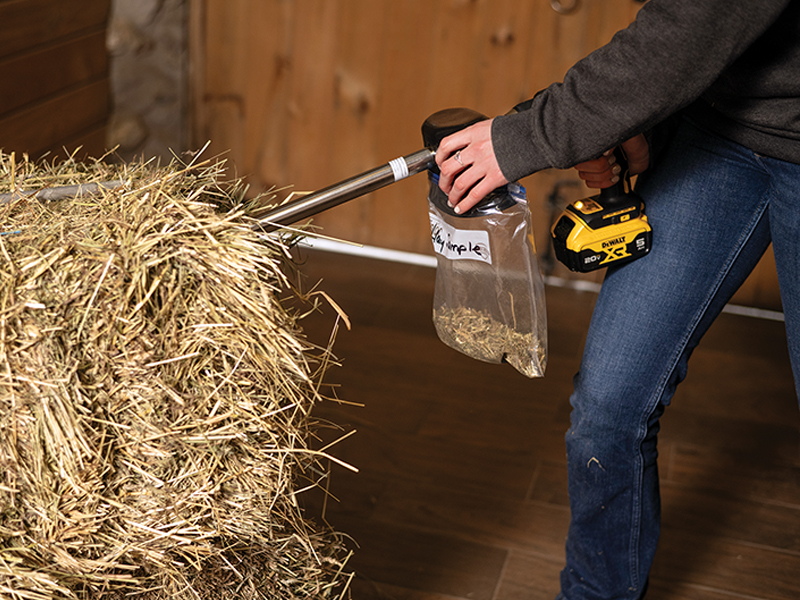
Using a hay probe to obtain a hay sample. A hay analysis is the only reliable way to determine the nutritional value of forage. Photo: Doswell Creative
Related: Feeding Show Horses: A Matter of Balance
If you do not have access to a hay probe, there are other ways to take and submit a sample. All you need is access to multiple hay bales, a pair of scissors, and a Ziplock® bag. (Figure 1)
FIGURE 1

Photos: Doswell Creative
Then follow these steps:
- Have multiple bales available from which to take handfuls of hay. Open each bale and take a handful. A minimum of 10 bales should be used to ensure that your sample is representative of the batch of hay.
- Within each bale, vary the location your sample is taken from. Most of the grab samples can be taken from the interior of the bale.
- Trim the ends of the handful to emulate a “core.” The handfuls should be trimmed to about three inches in length.
- During this process be careful not to crush any leaf matter as it is nutritionally important.
- Put all trimmed handfuls into one labelled Ziplock® bag and mix well. Prior to shipping the sample to your nearest lab, attach the laboratory’s sample submission form to the bag.
In Canada there are many different labs. Ensure that you are sending your sample for an equine analysis. For example, Ontario’s SGS Laboratory in Guelph and A&L Canada Laboratory in London both have equine-specific analyses. But if this task seems daunting, reach out to a qualified equine nutritionist in your area. They will be equipped with a forage probe to take an accurate hay sample and ship it to the nearest laboratory for you.
Ideal Forage Amount
Most horses will consume between 1.5-2.5 percent of their bodyweight in forage. If your horse easily maintains body condition and becomes over-conditioned, it is recommended to decrease the forage intake to closer to the 1.5 percent. However, if your horse is not overweight, or has a difficult time maintaining weight, closer to the 2.5 percent is preferable. If your horse is not overweight, providing free-choice access to forage is ideal. Following an equine body condition score system to ensure accuracy in evaluating your horse’s condition is recommended.

Estimate the weight of your horse using a weight tape by taking a measurement of the heart girth from about two inches behind the elbow, over the highest point of the withers, and hold it snugly straight up and down. Photo: Clix Photography
If the horse spends part of its day in a stall, a common practice is to provide a couple of flakes of hay at night check. Unfortunately, in these situations, horses will often consume their hay quickly and be left without any forage for hours, which is far from ideal. Therefore, by calculating the amount of hay your horse needs to maintain an optimal body condition and employing various management tactics, such as slow feeders or additional feedings as they are required, you can take better care of your horse through optimally supporting their gastrointestinal health.
Related: Hay, Haylage and Silage: What's the Difference?

A hay scale helps you to accurately determine the horse’s forage intake. Photo: Doswell Creative
INTERPRETING YOUR HAY ANALYSIS
When you are equipped with the detailed information from a hay analysis, you have a base upon which to build your horse’s optimal and accurate forage-based diet. A hay analysis provides you with specific nutritional information, such as energy content and crude protein percentage. It can be overwhelming if this is the first time you have had access to the results a hay analysis provides. However, if you stick to looking at the few key areas discussed below, you’ll quickly improve your understanding and move on to accurately feeding forage-first.
ADF, NDF and Lignin
Acid detergent fibre (ADF) and neutral detergent fibre (NDF) provide insight into the fibre components and digestibility of the hay. ADF measures cellulose and lignin. NDF measures cellulose, hemicellulose, and lignin. When these values are higher, it indicates a greater content of indigestible fibre as lignin is not digestible for the horse. On average, about 30-40 percent is normal for ADF, and 40-60 percent for NDF.
Digestible Energy (DE)
The ADF and NDF values will relate to the digestible energy content. As a general rule, when there is a great proportion of indigestible fibre in the hay, the amount of energy is lower. For easy keepers it would be preferable to have hay that is approximately 40 percent ADF and 55 percent NDF. However, for horses that struggle to maintain weight it is ideal to have ADF below 40 percent and NDF below 55 percent. The DE content of the hay will be given in Mcal/kg, which can be used to calculate how many calories that forage is providing to your horse.
Crude Protein (CP)
CP is an estimate of the total protein content of the hay. The average horse requires about 8 percent crude protein in their diet. This requirement will increase for horses in work or involved in breeding, such as broodmares.
Sugars & Starches
Water-soluble carbohydrates (WSC), ethanol-soluble carbohydrates (ESC), and starch will be included in the hay analysis. This is important for horses with metabolic disorders or at risk of developing laminitis. WSC includes both simple sugars and fructans (complex sugars) whereas ESC is only the simple sugars. For metabolic horses, it is recommended that the combined ESC and starch content not exceed a maximum of 10 percent.
Minerals
Hay will not meet all of your horse’s mineral requirements, but it is still important to look at these values to ensure there are no serious imbalances. For example, the calcium-to-phosphorus ratio should ideally be between 1.5:1 and 4:1. In most equine hay analyses this value will be calculated for you by the laboratory and provided on the analysis.
Related: The Impact of Antibiotics on the Equine Gut
SUPPLEMENTING HAY FOR BALANCED NUTRITION
To meet a horse’s vitamin and mineral requirements, it is important to choose the correct product to supplement your hay. The Nutrient Requirements of Horses, Sixth Revised Edition (2007), published by the National Research Council (NRC), provides nutrient requirements for various weight classes of horses, as well as how their nutrient requirements change with workload. You can use your hay analysis to calculate if it is meeting your horse’s requirements as outlined by the NRC. If your hay matches your horse’s needs well, then adding a simple ration balancer will be adequate.
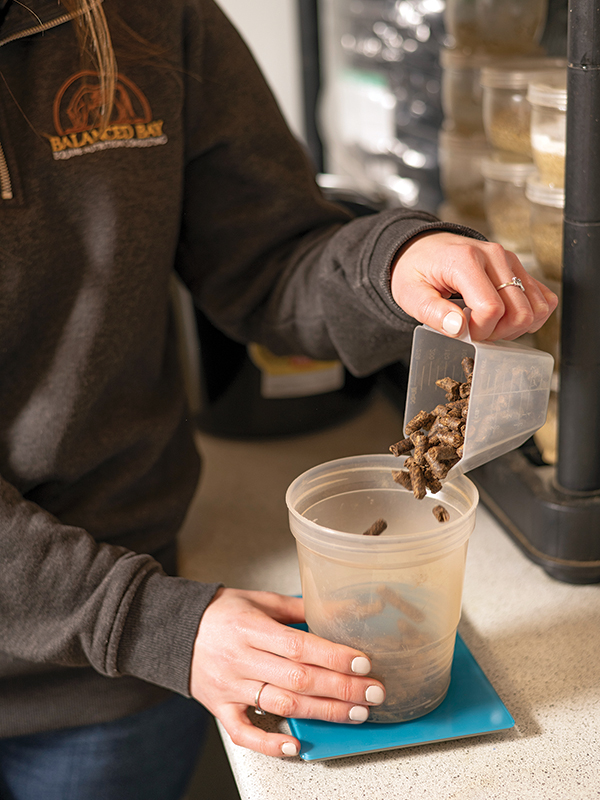
If your horse is an easy keeper or his energy needs are being met by forage, a simple ration balancer may be all that’s needed. Photo: Doswell Creative
Ration balancers are concentrated sources of vitamins, minerals, and sometimes protein as well. They do not provide a significant source of digestible energy and are therefore ideal for easy keepers and horses that have their energy needs met by their forage.
If the hay is not adequately meeting your horse’s energy and protein requirements you may have to opt for a performance feed. However, for most horses, it is easy to meet their additional energy requirements with products such as alfalfa cubes or beet pulp. Oils have also gained popularity for caloric supplementation.
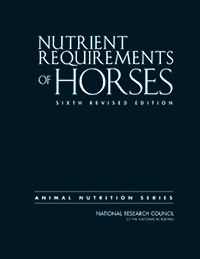
The Nutrient Requirements of Horses, Sixth Revised Edition 2007, published by the National Research Council, is used worldwide by equine nutritionists when formulating rations.
To summarize, feeding your horse a forage-based diet is important for their health. And taking steps to ensure that you are accurately feeding the forage can level-up your horse’s nutritional well-being. A hay analysis is always the crucial first step. If you have additional questions about hay testing, or your horse’s diet, consider consulting a qualified equine nutritionist.
Related: How to Make Rotational Grazing Work on Your Horse Farm
Related: The Dangers of Equine Obesity
Main Photo: Shutterstock/Alexia Khruscheva



